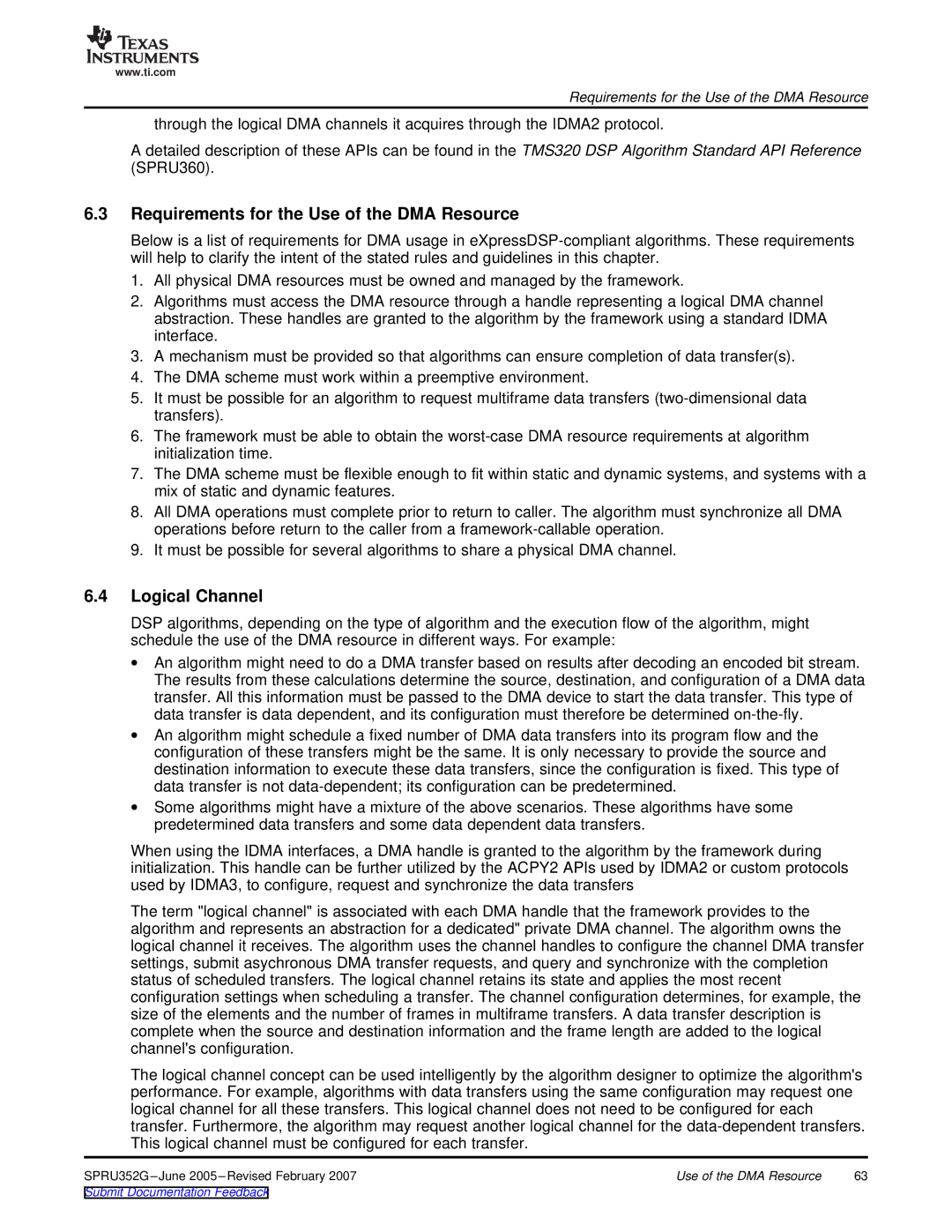
www.ti.com
Requirements for the Use of the DMA Resource
through the logical DMA channels it acquires through the IDMA2 protocol.
A detailed description of these APIs can be found in the TMS320 DSP Algorithm Standard API Reference (SPRU360).
6.3Requirements for the Use of the DMA Resource
Below is a list of requirements for DMA usage in
1.All physical DMA resources must be owned and managed by the framework.
2.Algorithms must access the DMA resource through a handle representing a logical DMA channel abstraction. These handles are granted to the algorithm by the framework using a standard IDMA interface.
3.A mechanism must be provided so that algorithms can ensure completion of data transfer(s).
4.The DMA scheme must work within a preemptive environment.
5.It must be possible for an algorithm to request multiframe data transfers
6.The framework must be able to obtain the
7.The DMA scheme must be flexible enough to fit within static and dynamic systems, and systems with a mix of static and dynamic features.
8.All DMA operations must complete prior to return to caller. The algorithm must synchronize all DMA operations before return to the caller from a
9.It must be possible for several algorithms to share a physical DMA channel.
6.4Logical Channel
DSP algorithms, depending on the type of algorithm and the execution flow of the algorithm, might schedule the use of the DMA resource in different ways. For example:
∙ An algorithm might need to do a DMA transfer based on results after decoding an encoded bit stream. The results from these calculations determine the source, destination, and configuration of a DMA data transfer. All this information must be passed to the DMA device to start the data transfer. This type of data transfer is data dependent, and its configuration must therefore be determined
∙ An algorithm might schedule a fixed number of DMA data transfers into its program flow and the configuration of these transfers might be the same. It is only necessary to provide the source and destination information to execute these data transfers, since the configuration is fixed. This type of data transfer is not
∙ Some algorithms might have a mixture of the above scenarios. These algorithms have some predetermined data transfers and some data dependent data transfers.
When using the IDMA interfaces, a DMA handle is granted to the algorithm by the framework during initialization. This handle can be further utilized by the ACPY2 APIs used by IDMA2 or custom protocols used by IDMA3, to configure, request and synchronize the data transfers
The term "logical channel" is associated with each DMA handle that the framework provides to the algorithm and represents an abstraction for a dedicated" private DMA channel. The algorithm owns the logical channel it receives. The algorithm uses the channel handles to configure the channel DMA transfer settings, submit asychronous DMA transfer requests, and query and synchronize with the completion status of scheduled transfers. The logical channel retains its state and applies the most recent configuration settings when scheduling a transfer. The channel configuration determines, for example, the size of the elements and the number of frames in multiframe transfers. A data transfer description is complete when the source and destination information and the frame length are added to the logical channel'sconfiguration.
The logical channel concept can be used intelligently by the algorithm designer to optimize the algorithm's performance. For example, algorithms with data transfers using the same configuration may request one logical channel for all these transfers. This logical channel does not need to be configured for each transfer. Furthermore, the algorithm may request another logical channel for the
SPRU352G | Use of the DMA Resource | 63 |
